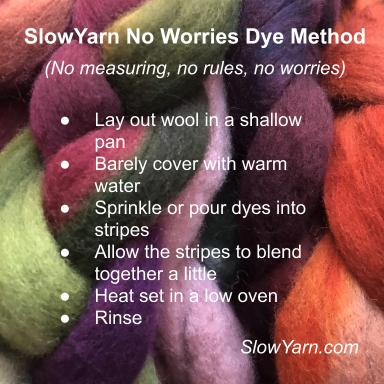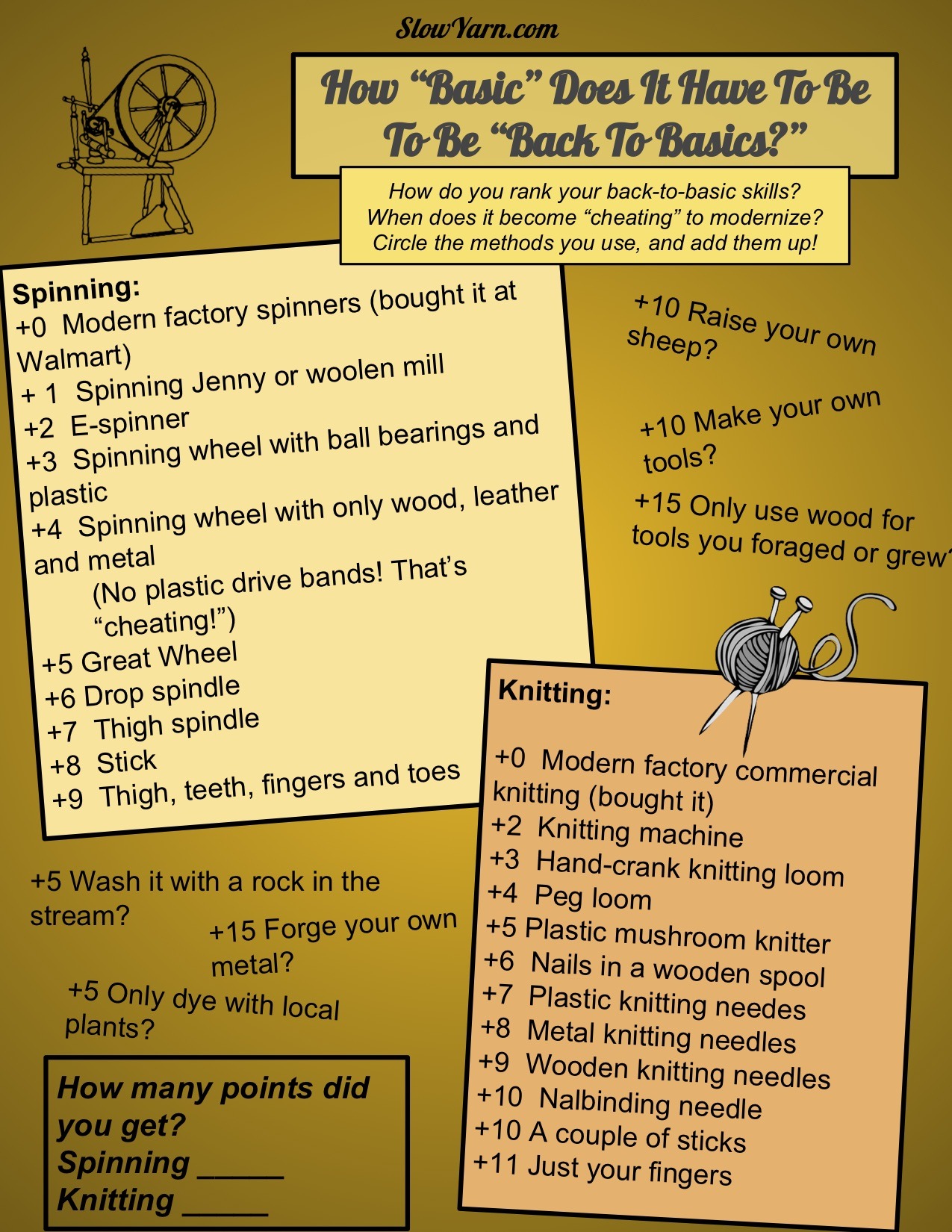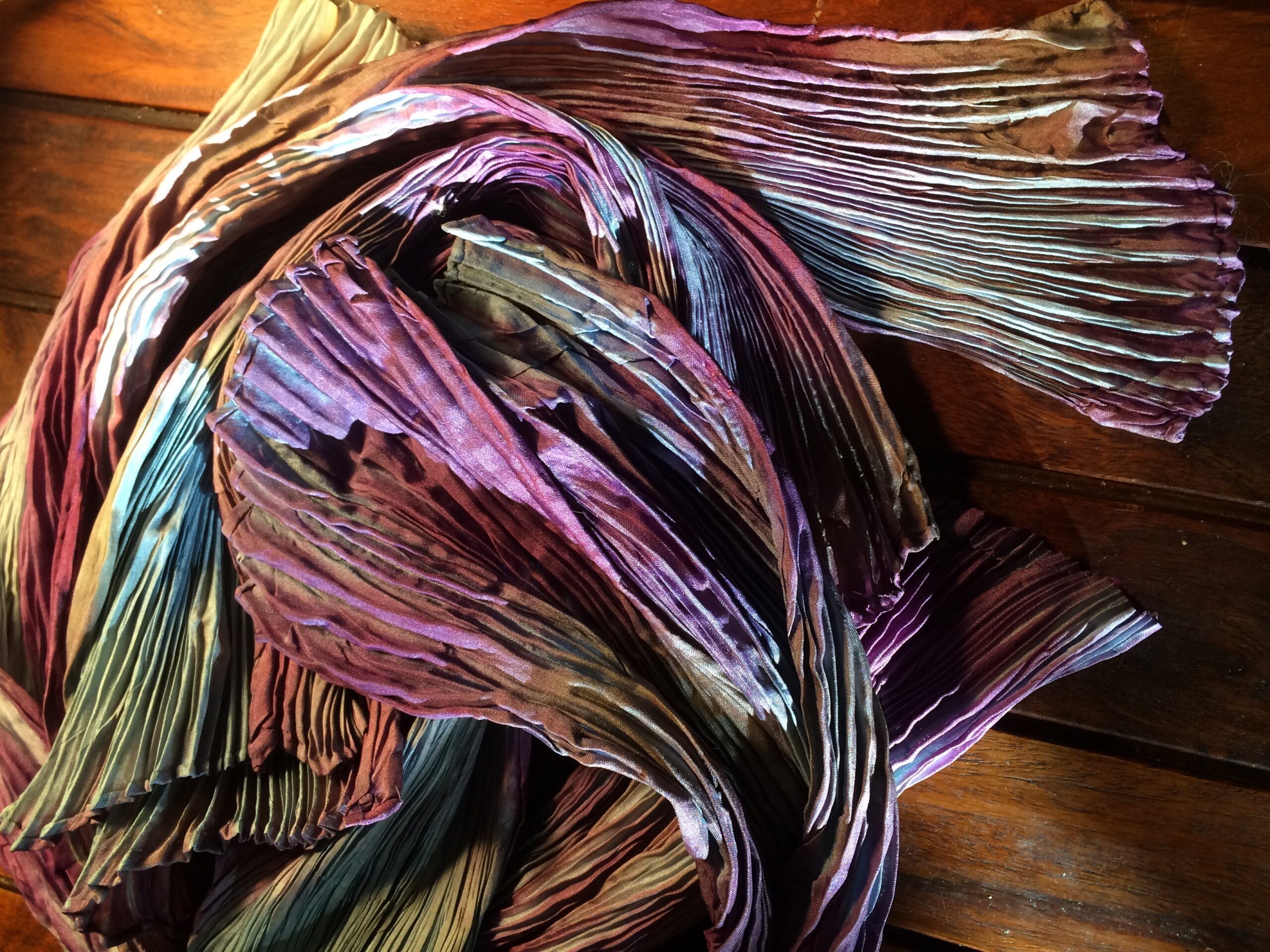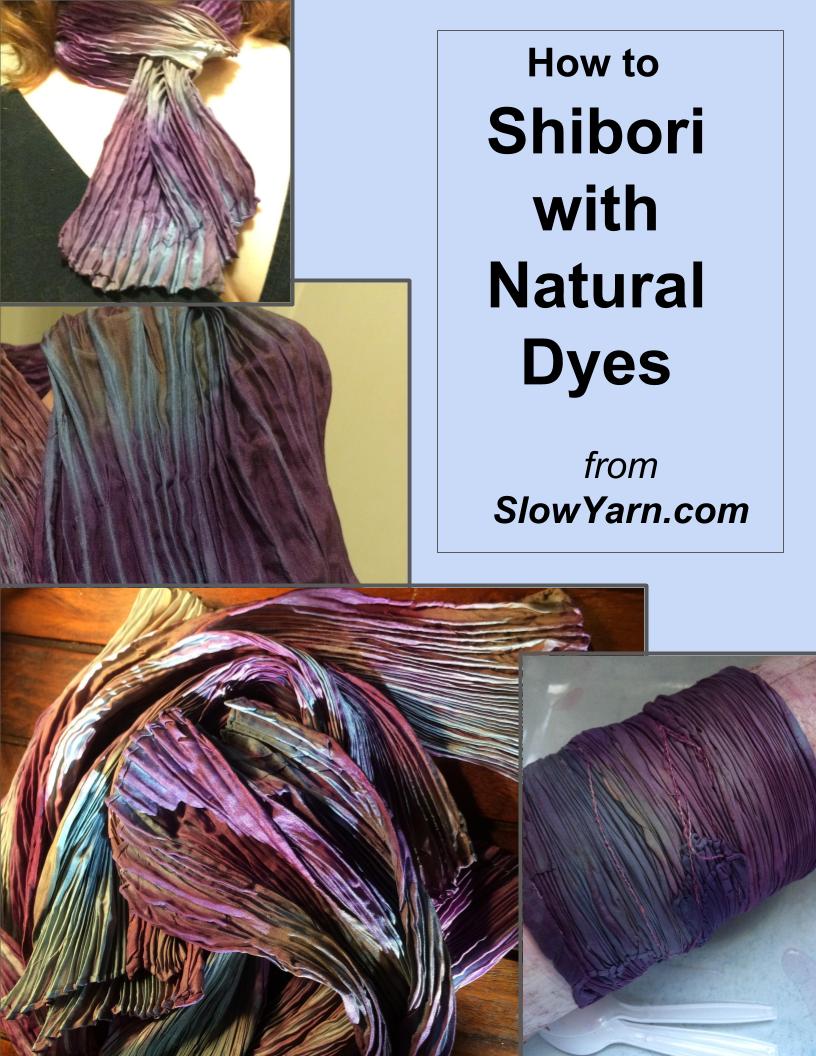Reading an MSDS for Home Dyers: Part 1

Understanding how to read a Material Safety Data Sheet (MSDS) is important for any home dyer. Especially if you are doing Natural Dyeing, or Eco Printing, it’s good to know just how “natural” or “eco” your materials really are. I’ll teach you how to read the information on an MSDS, which is available online for almost any chemical. Just use your search engine to find one!
Regardless of the chemicals you’re using (or not), please use safety precautions when dyeing at home. Never use pots, pans, or stirring utensils for cooking once they have been used for dyeing. Always wear latex or plastic gloves to protect the skin on your hands, and a dust mask to protect your lungs. If you’re using the kitchen, it’s a good idea to lay down a painter’s drop cloth of some sort over your counters to catch any dust from the dyes and keep them from your food prep area. Eye protection is a good idea, too. These are the same precautions every middle school science teacher demands of students working in a lab.
There has been a lot of discussion among natural dyers concerned about the safety of mordants. A mordant is some form of metal salt used in natural dyeing, generally as a preparation for the cloth or fiber to assist in the bonding of the dye with the fiber. Plant dyes, especially, can quickly fade in light or with washing and the use of a mordant extends the life of the color; mordants may change the resulting dye color, as well.
Because these mordants usually take the form of crystals or powders in plastic, non-corrosive jars they appear to be frighteningly non-organic-looking chemical products. Besides, hasn’t everybody seen that episode of “House” where the patient is suffering from heavy metal poisoning? (If you care, it’s Season 2, Episode 15, titled “Clueless.” I won’t tell you who done it, but it wasn’t the butler.)
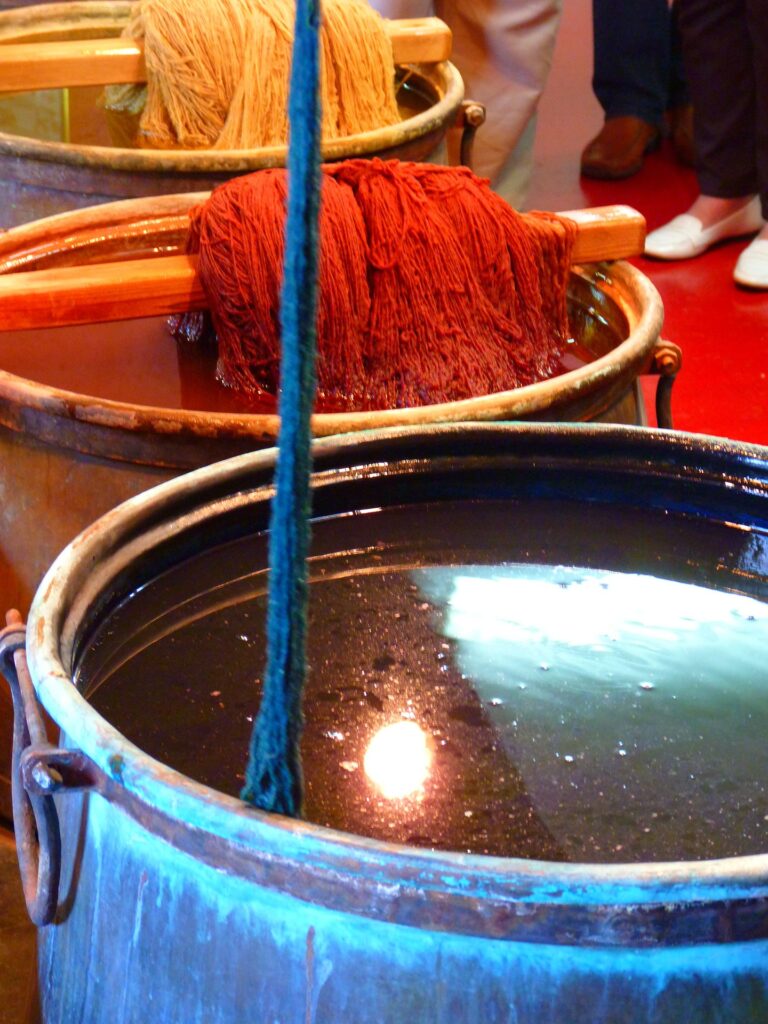
One chemical in particular has been the source of controversy in some natural dyeing groups online: Titanium Potassium Oxalate. I’m not somebody who is easily satisfied with unnecessary alarm over a chemical without actual knowledge. I’m also not happy with frivolous disregard to warnings about toxicity, so I set out to find real answers about Titanium Potassium Oxalate.
First of all, I’m going to keep referring to it with the full name because using abbreviations online has led to many misunderstandings. “Titanium-SomethingOxyish” is not an adequate way to name a chemical. Google searches compound this problem, because a search on Titanium Oxalate leads to links to anything about everything with the word “Titanium” in it, as though it’s all the same stuff.
The best source of information about any chemical is the MSDS sheet. (“Sheet” is actually redundant, because MSDS stands for Material Safety Data Sheet.) The EPA (in the US) requires that manufacturers publish these sheets for any chemical they produce, so that anyone working with their chemical, or any emergency worker responding to a chemical accident knows what to expect and how to treat the substance.
The problem is that there doesn’t seem to be any particular standard for the format of these sheets, or for the format of their rating systems. That means that one sheet may look like it’s written in Sanskrit, while the next is perfectly understandable.
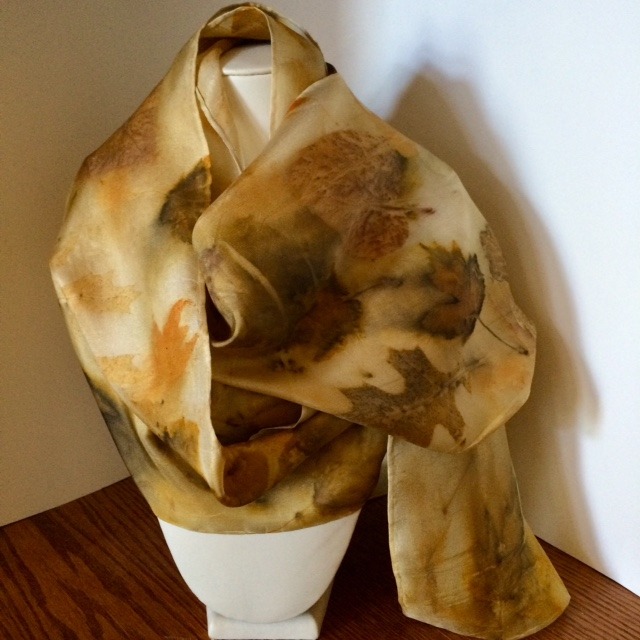
Let’s go over an MSDS for Titanium Potassium Oxalate Dihydrate offered by Pfalz and Bauer. Here is the link to that sheet: https://www.pfaltzandbauer.com/MSDS/T13475%20%20SDS%20%20031017.pdf
This is the “Hazards Identification” section for Titanium Potassium Oxalate Dihydrate, which is the chemical we’re discussing for use as a mordant.
Section 1: Chemical Product and Company Identification
This doesn’t need much explanation, I think, other than pointing out the name of the chemical. This is specifically the “dihydrate” form of Titanium potassium oxalate, which just means that for every one molecule of the oxalate there are two waters next to it to stabilize it. This is the correct chemical for use as a dye, and not to be confused with Titanium Dioxide which is used in sunscreen lotions. (More about that later.) Pfaltz and Bauer is the company manufacturing this chemical, and the publisher of this particular MSD Sheet.
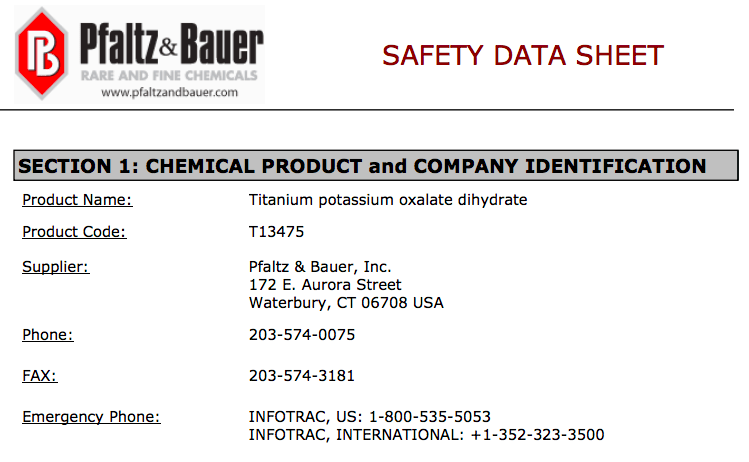
Section 2: Hazards Identification
This is the section we really need to look at closely. Most of the rest of the MSDS gets pretty generic, but this section ranks this one chemical in terms of health, fire, or reactive hazards.
First of all, don’t jump to conclusions when you see words like “hazard” or “acute” on this sheet. Those are like the questions, and the information after the colons gives the answers for this chemical.
So… ”The Statement of Hazard” and “Acute Health Hazard” and “Chronic Health Hazard” are not descriptors for Titanium Potassium Oxalate Dihydrate. They are the terms the MSDS uses to describe all chemicals, followed by the ranking of this particular chemical.
So, the type of health hazard for our Titanium Potassium Oxalate is as an irritant. We can see the ways it may be an irritant, but we don’t know yet how serious it is as an irritant. That is in the ranking systems that follow.
There are 3 different ranking systems used here, and they do NOT use the same numbering system! There is the HMIS Rating (Hazardous Materials Identification System), the NFPA Rating (National Fire Protection Association), and the GHS Classification (Globally Harmonized System.) Most MSDSheets have only ONE of these rankings, if at all! It’s pretty impressive that the manufacturer has gone to this much trouble to find information and have it available.
The HMIS Rating is:
- H(ealth):1, for “Slight Hazard.”
- F(lammability):0, for “none.”
- R(eactivity):0, for “none.” (There is a P on this sheet where an R should be—it’s just a typo. HMIS follows the same categories as NFPA.)
The NFPA Rating is the same as HMIS, and ranked the same way, with 1 for Slight Hazard.
The disclaimer underneath is interesting to us, since it admits that they don’t know how much research has been done on this chemical, especially as to long term effects. It’s been around for about 100 years, but mostly used by large scale dyeing or leather dyeing industry where safety equipment is standard. As a chemical available to the home dyer, it is fairly new.
Next, we have the GHS Classification. GHS stands for “Globally Harmonized System,” which was developed by the United Nations. (Here is a link to a great article explaining how this system works: https://www.era-environmental.com/blog/ghs-hazard-classification )The ranking here follows the INVERSE direction with its ranking numbers! A 1 with GHS would be a really bad hazard, whereas a 4 is only a slight hazard. So, the chemical’s hazard ranking equates to the HMIS or NFPA rankings, even though the numbers looked alarming at first.
Don’t forget, the use of terms like “Acute toxicity” are referring to chemicals in general, followed by the ranking of this particular chemical. The GHS breaks down the ranking of this as an irritant with more detail than the other ranking systems do. As a skin irritant, for example, they rank this as a 2— so definitely wear gloves and eye protection. It’s not likely that you’ll be exposed if you’re using this as a normal mordant, but if you get a case of clumsy with the jar you’ll want to be protected.
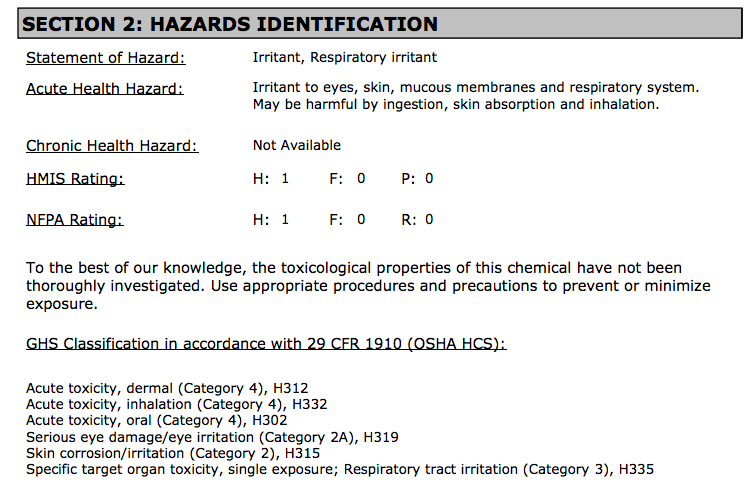
All in all, Titanium Potassium Oxalate is a pretty benign chemical as long as you are using the normal precautions: gloves, particle mask, and don’t drink it. Because of the GHS classification as a Category 3 in respiratory tract irritation, I’d recommend that your dust mask should be a good one that filters particulates and not just a scrap of paper over your nose like a Dollar Store dust mask. I own one because, well, breathing dust is bad. Mixing glazes for ceramics, sculpting marble or even wood raises a lot of dust. (I wonder if there is an MSDS for animal dander, too?)
In Part 2 of this article, I’ll continue to go over the MSDSheet, which will include disposal regulations and recommended first aid measures if you are exposed.
Resources:
- https://www.osha.gov/Publications/OSHA3514.html . Administration, OSHA. “UNITED STATES DEPARTMENT OF LABOR.” Occupational Safety and Health Administration, 26 June 2015, www.osha.gov/Publications/OSHA3514.html.
- http://artcatering.com/wp-content/uploads/2015/07/Windex.pdf . P&G Professional. “MSDS Comet Cleaner with Bleach- Ready to Use.” MSDS Comet Cleaner with Bleach- Ready to Use, Proctor & Gamble Inc., 9 Jan. 2015, sds.chemtel.net/webclients/cheneybrothers/508065sds.PDF.
- http://www.trac360.com/blog/chemicals/the-9-hazard-communication-standard-pictograms/ “The 9 Hazard Communication Standard Pictograms.” BLR Chemical Lists, BLR®—Business & Legal Resources, 2016, www.trac360.com/blog/chemicals/the-9-hazard-communication-standard-pictograms/.
- https://www.icriforum.org/sites/default/files/ICRI_Sunscreen.pdf. Wood, Elizabeth. “Impacts of Sunscreens on Coral Reefs.” Impacts of Sunscreens on Coral Reefs, ICRI Briefing: Government of Sweden, Feb. 2018, www.icriforum.org/sites/default/files/ICRI_Sunscreen.pdf.
- https://communities.acs.org/community/science/sustainability/green-chemistry-nexus-blog/blog/2013/02/13/chemistry-and-coral-reefs-bleaching-and-greening Co, Alex. “ACS Network Chemistry Community Online.” Nontraditional Career Paths in Chemistry | ACS Network, ACS Chemistry Community Online, 13 Feb. 2013, communities.acs.org/community/science/sustainability/green-chemistry-nexus-blog/blog/2013/02/13/chemistry-and-coral-reefs-bleaching-and-greening.
- https://www.era-environmental.com/blog/ghs-hazard-classification Mali, Ria. “GHS Hazard Classification: Everything You Need to Know.” GHS Hazard Classification: Everything You Need To Know, ERA- Environmental Management Solutions, 2016, www.era-environmental.com/blog/ghs-hazard-classification.
- https://www.pfaltzandbauer.com/MSDS/T13475%20%20SDS%20%20031017.pdf “MSDS Titanium Potassium Oxalate Dihydrate.” Pfaltz and Bauer MSDS Titanium Potassium Oxalate Dihydrate, Pfaltz and Bauer, 1 Oct. 2018, www.pfaltzandbauer.com/MSDS/T13475%20%20SDS%20%20031017.pdf.
- https://en.wikipedia.org/wiki/Hazardous_Materials_Identification_System “Hazardous Materials Identification System.” Wikipedia, Wikimedia Foundation, 13 Dec. 2018, en.wikipedia.org/wiki/Hazardous_Materials_Identification_System.
- https://webcache.googleusercontent.com/search?q=cache:jlSbirXIcD0J:https://www.fm.colostate.edu/files/forms/safety/CH-23.NFPA.ratings.pdf+&cd=12&hl=en&ct=clnk&gl=us Bailey, A. NATIONAL FIRE PROTECTION ASSOCIATION (NFPA) RATING SYSTEM. National Fire Protection Association, 2009, www.fm.colostate.edu/files/forms/safety/CH-23.NFPA.ratings.pdf.
- https://calvin.edu/contentAsset/raw-data/584e5725-330d-4667-843d-bdb87c10875f/fileToAttach3 . “HMIS Labeling System.” Calvin College, 21 December 2010, https://calvin.edu/contentAsset/raw-data/584e5725-330d-4667-843d-bdb87c10875f/fileToAttach3
- https://prochemicalanddye.net/downloads/dl/file/id/35/product/0/potassium_aluminum_sulfate_sds.pdf “Safety Data Sheet Potassium Aluminum Sulfate.” Safety Data Sheet Potassium Aluminum Sulfate, Pro Chemical and Dye, 10 Sept. 2013, prochemicalanddye.net/downloads/dl/file/id/35/product/0/potassium_aluminum_sulfate_sds.pdf.
- https://www.dharmatrading.com/images/public/pdf/msds/AAM_2017.pdf Hattori, Kathy. “SAFETY DATA SHEET ALUMINUM ACETATE, DIBASIC.” SAFETY DATA SHEET ALUMINUM ACETATE, DIBASIC, Dharma Trading Co: Botanical Colors LLC, 30 June 2017, www.dharmatrading.com/images/public/pdf/msds/AAM_2017.pdf.
Copyright Kelley Adams 2019 -2023 All rights reserved.
Comments are welcome, or for any questions, please contact Kelley@slowyarn.com

